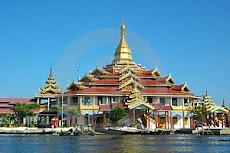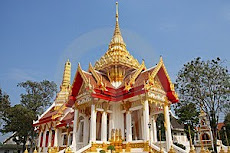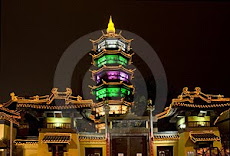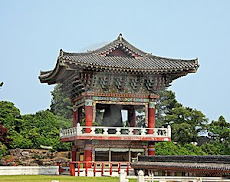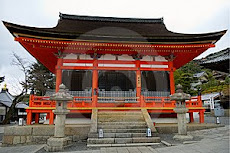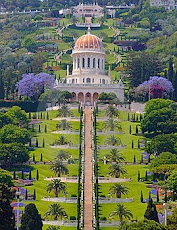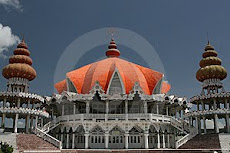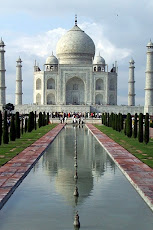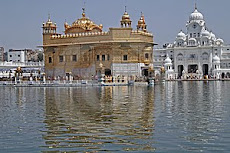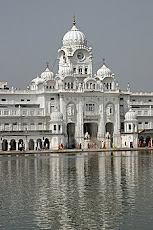Wednesday, December 30, 2009
Biography of Buddha
Tuesday, December 29, 2009
Sikhism
Sikhism (sĭk'ĭzəm), religion centered in the Indian state of Punjab, numbering worldwide some 19 million. Some 300,000 Sikhs live in Britain, and there are smaller communities in North America, Australia, and Singapore. By the late 1990s Sikhism was the world's fifth largest faith and had some 175,000 U.S. adherents and 225,000 in Canada. Sikhism is heterodox, combining the teachings of Bhakti Hinduism and Islamic Sufism.
The founder and first Sikh guru, the mystic Nanak (c.1469-c.1539), proclaimed monotheism, the provisional nature of organized religion, and direct realization of God through religious exercises and meditation; he opposed idolatry, ritual, an organized priesthood, and the caste system. Angad (1504-52), the second guru, separated the ascetics (udasis) from the laity, eliminated most features of Hinduism, and introduced the Gurmukhi script. Under the fourth guru, Ram Das, Amritsar was founded as a sacred city. Arjun, the fifth guru, compiled devotional poetry by earlier Sikh gurus and other prominent saints into the Sikh scripture, the Adigranth, which remains central to Sikh religious life. Under succeeding gurus the Sikh community gradually united and began to develop military power; the Mughal emperor Aurangzeb responded by executing the ninth guru and ordering the destruction of Sikh temples.
In 1699, Govind Singh (1666-1708), the tenth and final guru, instituted certain practices that have become fundamental to Sikh identity. Through an initiatory rite, after which the initiate takes the surname Singh [lion], he created the military fraternity called the Khalsa, or "pure," whose ideal was the soldier-saint. He introduced the Sikh practices of wearing a turban, carrying a dagger, and never cutting the hair or beard.
By the late 18th cent. the Sikhs had conquered most of the Punjab and established various feudal states; their greatest leader was Ranjit Singh (1780-1839), who established a Sikh kingdom in the Punjab. After his death, conflict with the British caused the Sikh Wars and the subjugation of the Punjab, after which Sikh soldiers formed a significant part of the British armies in India. Despite Sikh protests, the 1947 partition of the Indian subcontinent divided their homeland. Militant Sikhs and Hindu Jats fought the Muslims of Punjab in a struggle that resulted in over a million casualties. Some 2.5 million Sikhs migrated from West Punjab (in Pakistan) into East Punjab (in India). The years immediately following partition brought a period of relative stability and prosperity.
More recently, militant Sikhs have called for an autonomous Sikh state, Khalistan, within or separate from India. Turmoil in the Punjab erupted in the early 1980s, marked most dramatically by the 1984 storming by the Indian Army of the Golden Temple at Amritsar, which had been taken over by militant Sikhs. Prime Minister Indira Gandhi was assassinated by her Sikh bodyguards in reprisal, after which mobs (some incited by local Congress party leaders) massacred Sikhs throughout India: in Delhi alone, more than 3,000 Sikhs were killed. Religious hostilities and communal violence in the Punjab continued into the early 1990s.
Bibliography
See K. Singh, A History of the Sikhs (2 vol., 1963-66); J. D. Cunningham, A History of the Sikhs (repr. 1966); G. Singh, The Religion of the Sikhs (1971); W. H. McLeod, Guru Nanak and the Sikh Religion (1976); J. O'Connell, ed., Sikh History and Religion in the Twentieth Century (1988).
--------------------------------------------------------------------------------
Monday, December 28, 2009
Buddhism's Core Beliefs

Core beliefs of Buddhism:
Buddhism, like most of the great religions of the world, is divided into a number of different traditions. However, most traditions share a common set of fundamental beliefs.
One fundamental belief of Buddhism is often referred to as reincarnation -- the concept that people are reborn after dying. In fact, most individuals go through many cycles of birth, living, death and rebirth. A practicing Buddhist differentiates between the concepts of rebirth and reincarnation. In reincarnation, the individual may recur repeatedly. In rebirth, a person does not necessarily return to Earth as the same entity ever again. He compares it to a leaf growing on a tree. When the withering leaf falls off, a new leaf will eventually replace it. It is similar to the old leaf, but it is not identical to the original leaf.
After many such cycles, if a person releases their attachment to desire and the self, they can attain Nirvana. This is a state of liberation and freedom from suffering.
The Three Trainings or Practices:
These three consist of:
Sila: Virtue, good conduct, morality. This is based on two fundamental principles:
The principle of equality: that all living entities are equal.
The principle of reciprocity: This is the "Golden Rule" in
Christianity -- to do onto others as you would wish them to do
onto you. It is found in all major religions.
Samadhi: Concentration, meditation, mental development. Developing one's mind is the path to wisdom which in turn leads to personal freedom. Mental development also strengthens and controls our mind; this helps us maintain good conduct.
Prajna: Discernment, insight, wisdom, enlightenment. This is the real heart of Buddhism. Wisdom will emerge if your mind is pure and calm.
The first two paths listed in the Eightfold Path, described below, refer to discernment; the last three belong to concentration; the middle three are related to virtue.
The Four Noble Truths:
The Buddha's Four Noble Truths explore human suffering. They may be described (somewhat simplistically) as:
Dukkha: Suffering exists: (Suffering is real and almost universal. Suffering has many causes: loss, sickness, pain, failure, the impermanence of pleasure.)
Samudaya: There is a cause for suffering. (It is the desire to have and control things. It can take many forms: craving of sensual pleasures; the desire for fame; the desire to avoid unpleasant sensations, like fear, anger or jealousy.)
Nirodha: There is an end to suffering. (Suffering ceases with the final liberation of Nirvana (a.k.a. Nibbana). The mind experiences complete freedom, liberation and non-attachment. It lets go of any desire or craving.)
Magga: In order to end suffering, you must follow the Eightfold Path.
The Five Precepts:
These are rules to live by. They are somewhat analogous to the second half of the Ten Commandments in Judaism and Christianity -- that part of the Decalogue which describes behaviors to avoid. However, they are recommendations, not commandments. Believers are expected to use their own intelligence in deciding exactly how to apply these rules.
Do not kill. This is sometimes translated as "not harming" or an absence of violence.
Do not steal. This is generally interpreted as including the avoidance of fraud and economic exploitation.
Do not lie. This is sometimes interpreted as including name calling, gossip, etc.
Do not misuse sex. For monks and nuns, this means any departure from complete celibacy. For the laity, adultery is forbidden, along with any sexual harassment or exploitation, including that within marriage. The Buddha did not discuss consensual premarital sex within a committed relationship; Thus, Buddhist traditions differ on this. Most Buddhists, probably influenced by their local cultures, condemn same-sex sexual activity regardless of the nature of the relationship between the people involved.
Do not consume alcohol or other drugs. The main concern here is that intoxicants cloud the mind. Some have included as a drug other methods of divorcing ourselves from reality -- e.g. movies, television, the Internet. 1
Those preparing for monastic life or who are not within a family are expected to avoid an additional five activities:
6. Taking untimely meals.
7. Dancing, singing, music, watching grotesque mime.
8. Use of garlands, perfumes and personal adornment.
9. Use of high seats.
10. Accepting gold or silver.
There is also a series of eight precepts which are composed of the first seven listed above, followed by the eighth and ninth combined as one. "Ordained Theravada monks promise to follow 227 precepts!" 3
The Eightfold Path:
The Buddha's Eightfold Path consists of:
Panna: Discernment, wisdom:
1) Samma ditthi Right Understanding of the Four Noble Truths
2) Samma sankappa: Right thinking; following the right path in life
Sila: Virtue, morality: 3) Samma vaca: Right speech: no lying, criticism, condemning, gossip, harsh language
4) Samma kammanta Right conduct by following the Five Precepts
5) Samma ajiva: Right livelihood; support yourself without harming others
Samadhi: Concentration, meditation: 6) Samma vayama Right Effort: promote good thoughts; conquer evil thoughts
7) Samma sati Right Mindfulness: Become aware of your body, mind and feelings
8) Samma samadhi Right Concentration: Meditate to achieve a higher state of consciousness
Monday, November 2, 2009
Buddhism
For others it is a philosophy or a culture. There are so many kinds of Buddhism and so many contradictions within the overall tradition that it is almost impossible to define, but there are important common threads. The so-called “Three Jewels” (Triratna)—Buddha (see Buddha, Gautama Buddha), dharma (see Dharma), and saṇgha—are essential elements for Buddhists. In most sects there is the presence of certain of the teachings or concepts of Gautama Buddha, the Buddha Sākyamuni, who lived in Nepal and India some 2,500 years ago. Of primary importance to these teachings are śūnyatā, the sense of selflessness achieved by way of inner searching—often in a monastic setting—and a goal of nirvāna (see Nirvāna), or Enlightenment. Dharma, or proper behavior and truth, in the Buddhist world is manifested in the life and teachings of the Buddha. Saṇgha, or “community,” is the holy community of Buddhists, a place of spiritual refuge. Saṇgha can refer to a community of nuns or monks or to any group of devoted and spiritually committed Buddhists. At the basis of saṇgha are the “Four Noble Truths” of the Buddha's teaching. These are (1) the acceptance of dukkha, or transience and the suffering which comes with it; (2) the realization that it is tanhā, or the “thirst” for permanence that leads to suffering; (3) the understanding that by eliminating taṇha, dukkha can be overcome and nirvāna achieved; and (4) the AṣṠgika-mārga, or “Eightfold Path” to the elimination of taṇha taught by the Buddha in the first sermon after his Enlightenment.
The Eightfold Path contains the elements necessary to Enlightenment. These are (1) perfected understanding of the Four Noble Truths; (2) non-attachment; (3) perfected speech; (4) perfected conduct; (5) the pursuit of livelihood in such a way as to do no harm to others; (6) the production of good karma (see Karman); (7) the development of meditative mindfulness; and (8) perfected concentration.
A major division between Buddhists centers around the question of boddhisatvas (see Boddhisattva) and whether emphasis should fall on the individual salvation or that of the larger society. There are two major paths or “vehicles” (yāna) in Buddhism. The older Hīnayāna (see Hīnayāna Buddhism) or “Lesser Vehicle,” so termed by the reformist Mahāyāna (see Mahāyāna Buddhism) or “Larger Vehicle” group, is represented, for instance, by the Theravāda (see Theravāda Buddhism) and Sarvāstivāda sects which developed in India before the Common Era and have spread to various parts of the Asian continent. The Hīnayāna approach stresses the ideal of the arhat (see Arhat), the enlightened one who has attained nirvāna. The Mahayana groups stress the ideal of the bodhisattva, not as the earlier stages of Gautama Buddha's movement toward Enlightenment, but as the person concerned with achieving Buddhahood only in some distant eon as he works compassionately in this world for the salvation of others. It should be noted that within the larger divisions of Hīnayāna and Mahāyāna exist many diverse understandings and doctrinal divisions.
The original literature of Hīnayāna Buddhism is written primarily in the Middle India dialect of Sanskrit called Pāli (see Pāli). The Pāli Abhidhamma PiṠaka, for instance contains sermons (suttas) and Theravādan doctrine. The primary Mahāyāna scriptural form is the sūtra (sermon of the Buddha), which is traditionally recited or chanted as a form of worship. The best known of the sūtras is probably The Lotus Sūtra (the Saddharmapuṇḍarīka Sūtra), which has a strong narrative aspect and stresses the relationship of all people to the deeds of the Buddha himself.
More esoteric forms of Buddhism include the Tantric tradition (see Tantric entries) and Zen Buddhism (see Zen Buddhism). Tantric Buddhism is influenced by Brahamanism (see Brahmanism) and is concerned with yogic (see Yoga) paths to salvation stressed in rituals and in texts called tantras. Zen, primarily practiced in Japan, developed from Chinese Ch'an Buddhism and emphasizes meditation rather than the worship of idols.
The myths of Buddhism are associated with the life of Gautama Buddha and are found primarily in the Pāli-language canon of the Theravāda tradition in first century BCE Sri Lanka, although stories have emerged from other traditions as well.
US History Encyclopedia: Buddhism
Top Home > Library > History, Politics & Society > US History EncyclopediaBy 2002 Buddhism had become highly visible in many countries outside of Asia. Although it never became nearly as popular as in Asia, by the 1990s Buddhism's influence on America was visible in the arts, in the steadily increasing number of converts and Buddhist institutions, and in the growing recognition of Buddhist groups as participants in the multireligious composition of U.S. society. In each Asian culture, it generally took many centuries for Buddhism to acculturate. In contrast, in the West, attempts to create adapted, regionalized forms of Buddhism occurred at a much faster pace. New schools and lineages additionally pluralized the spectrum of Buddhist traditions present in Western countries.
History
The origin of Buddhism in America can be traced to Chinese immigrants who began to appear on the West Coast in the 1840s. By 1852, around 20,000 Chinese were present in California, and within a decade, nearly one-tenth of the state's population was Chinese.
Japanese Buddhism developed more slowly in America than the Chinese form, but had much greater impact. By 1890, the Japanese population in the United States was barely 2,000. The World Parliament of Religion, held in 1893, radically changed the landscape for Japanese Buddhism in America. Among the participants was a Rinzai Zen monk, Shaku So[UNK]en, who returned to America in 1905, lecturing in several cities, and establishing a basic ground for the entry of Zen. Upon his return to Japan in 1906, three of his students were selected to promote Rinzai in America: Nyo[UNK]gen Senzaki, Shaku So[UNK]katsu, and Daisetz Teitaro Suzuki.
Rinzai was one of several Zen traditions to develop in America. So[UNK]to[UNK] Zen began to appear in America in the 1950s, and by the mid-1950s, Soyu Matsuoka Ro[UNK]shi had established the Chicago Buddhist Temple. Shunryu Suzuki Ro[UNK]shi arrived in San Francisco in 1959, founding the San Francisco Zen Center shortly thereafter. His (mostly Western) successors continued the So[UNK]to[UNK] lineage. Another form of Zen that took root in America attempts to harmonize the major doctrines and practices of each school into a unified whole. Proponents of this approach include Taizan Maezumi Ro[UNK]shi (who arrived in 1956), Hakuun Yasutani Ro[UNK]shi (who first visited the United States in 1962), and Philip Kapleau. Also significant are Robert Aitken Ro[UNK]shi, who founded the Diamond Sangha in Hawaii in 1959, Eido[UNK] Shimano Ro[UNK]shi, who first came to the United States as a translator for Yasutani Ro[UNK]shi, and Joshu Sasaki Ro[UNK]shi, who founded the Cimarron Zen Center in Los Angeles in 1968 and the Mt. Baldy Zen Center three years later.
Zen was not the only Japanese Buddhist tradition to make an appearance in America before the turn of the twentieth century. In 1899 two Japanese missionaries were sent to San Francisco to establish the Buddhist Mission of North America, an organization associated with the Pure Land school of Japanese Buddhism. Reincorporated in 1944 as the Buddhist Churches of America, it remains one of the most stable Buddhist communities in North America.
In the 1960s, another form of Japanese Buddhism, now known as So[UNK]ka Gakkai International-USA, appeared on the American landscape, and by 1974 it boasted over 200,000 members. This group grew out of the So[UNK]ka Gakkai movement in Japan, a nonmeditative form of Buddhism that based its teachings on the thirteenth century figure Nichiren (1222–1282). Although the group splintered in the late twentieth century, it remained a formidable Buddhist presence in America, having become extremely attractive to European American and African American Buddhists.
At the same time the Chinese were once again making their presence visible in American Buddhism. One notable addition was a largely monastic group known as the Dharma Realm Buddhist Association, created by a venerable monk named Hsüan-Hua. Of even larger size was the Hsi-Lai Temple outside Los Angeles, founded in 1978, and eventually offering a wide variety of Buddhist teachings and services. By 2002 Chinese Buddhist groups could be found in virtually every major metropolitan area.
The Buddhist culture to enter America most recently is the Tibetan. Although a few Tibetan Buddhist groups appeared in the West prior to 1960, the majority came after China's invasion and occupation of their country. Communities from each of the four major Tibetan sects can now be found in America. The Tibetan groups were the most colorful of all the Buddhist groups prospering in late twentieth century America, possessing a rich tradition of Buddhist art and a powerful psychological approach to mental health. In the early 2000s they continued to grow rapidly.
The final sectarian tradition to be considered is that of the Therava[UNK]da. Most recently, groups from Laos, Cambodia, Thailand, and Myanmar migrated to the United States to escape the economic and political uncertainty of their native countries. Therava[UNK]da temples sprang up in the Southeast Asian enclaves of major cities. The Therava[UNK]dabased Vipassana[UNK] movement became the most attractive form of this tradition among Euro-Americans.
Institutional Issues
Five areas of institutional concern can be outlined in the American Buddhist tradition: ethnicity, practice, democratization, engagement, and adaptation. Two questions help to contextualize these mutually influencing issues: first, how Buddhist identity is determined, and finally, the degree to which ecumenicity might play a role in providing a unifying instrument for the exceedingly diverse spectrum of Buddhist traditions in North America.
Who is a Buddhist? Identifying and quantifying American Buddhists has been an important issue. By the mid-1990s, scholars estimated the American Buddhist population to be four to five million. Although there were many possible methods of determining Buddhist identity in America, the most accepted approach was that of self identification. This approach allowed each group to be counted regardless of how they interpreted and practiced Buddhism.
Ethnicity. One late twentieth century attempt to quantify the American Buddhist population estimated that of the total Buddhist population in the United States, perhaps 800,000 were Euro-American convert Buddhists. This suggested that the vast majority of Buddhists in America were Asian immigrants. The relationship between Asian American Buddhists and converted Buddhists was tenuous.
Practice. There was no disagreement among researchers that Asian immigrant Buddhist communities and American convert communities engaged in significantly different expressions of Buddhist practice. The general consensus was that American converts gravitate toward the various meditation traditions, while Asian immigrants maintain practices consistent with ritual activity or Pure Land observance.
Democratization. While Asian Buddhism was, for the most part, primarily hierarchical and highly authoritarian, the forms of American Buddhism that developed in the late twentieth century underwent a process of democratization. It could be observed in changing patterns of authority in the various Buddhist sanghas, or communities, highlighted by a reevaluation of the relationship between the monastic and lay communities. Second, democratization could be witnessed in changing gender roles in American Buddhism, especially in the prominence of women. Finally, it could be seen in the manner in which individuals pursuing a nontraditional lifestyle, particularly with regard to sexual preferences, found a meaningful role in American Buddhist communities.
Engagement. "Socially engaged Buddhism" has application to a wide variety of general human rights issues, such as antiviolence and environmental concerns, but also to the lives of individual Buddhists. The greatest challenge for socially engaged Buddhism in the West is organizational. In the early 2000s, it was far less developed in its organizational patterns and strategies than its Christian or Jewish counterparts. Nonetheless, an exciting array of activities could be documented in the records of the individual American Buddhist communities.
Adaptation. Perhaps the one issue that dominated the early comprehensive books on American Buddhism was adaptation or acculturation. As one early researcher asked, "Is there a characteristically American style of Buddhism?" Some North American Buddhists were concerned about the implications of altering the Buddhist tradition in the name of adaptation. American Buddhism has created, in addition to its distinct practices, a series of enterprises that Asian Buddhism never imagined: residential communities, businesses, farms, hospices, publishing companies, meditation products, cottage industries, and the like. Critics worried that these innovations represented a distraction from the purpose of Buddhist practice.
Ecumenicism. In each of the issues cited above, it is possible to discern the need for cooperative discussions between American Buddhists of all traditions. In July 1987, a conference on world Buddhism in North America was sponsored by the Zen Lotus Society in Ann Arbor, Michigan. It included a wide variety of talks, panel discussions, and meetings in an effort to bring together representatives of the Buddhist traditions in America to work together toward common goals. In the end, they sought to create a protective umbrella under which the issues of ethnicity, practice, democratization, engagement, and adaptation could be addressed productively, ushering in a successful future for the Buddhist movement in America.
Jainism
"Jain" means "conqueror." Its founder, Mahavira ("Great Hero"), was a contemporary of the Buddha, Confucius, Lao Tzu, and the Hebrew prophets Jeremiah, Ezekiel, and Isaiah. With the possible exception of Lao Tzu and Confucius, none of these men met or were influenced by each other, but the times certainly must have been ripe for spiritual movements.
Much like the Buddha, Mahavira's principal concept was that of dualism. The universe consists of the two opposing forces of good and evil. But where the Buddha discovered the Middle Way between the two, Mahavira proposed another philosophy. He understood the "good" in terms of soul, or life. Evil was lifeless, or matter. Soul or feelings exist in everything, even the dust of the ground or rocks of the landscape. But soul is entrapped in matter, "coated," so to speak, forming a material covering imposed by karma (See Hinduism). The human predicament is that the body (material, evil) is thus a form of prison for the soul (spiritual, good). So since karma placed you into this shell, the only way to break out is by extreme asceticism (See Ascetic).
This is to be carried out through five principal activities:
Non-injury to life
Truthfulness
Taking nothing unless it is offered
Celibacy
Renouncement of all attachments
Pertaining to the first activity, Jains are vegetarians. Some even place screens over lamps to keep moths from hurting themselves in the flames. Others wear masks to keep from breathing in insects or sweep the path before them to avoid stepping on and crushing ants or bugs. This extreme form of attention is meant to avoid bad karmic repercussions in the next life.
Certainly the most well known of those influenced by Jainism was Mahatma Gandhi (See Gandhi, Mahatma). Mahavira's principles, especially those concerning non-injury, greatly shaped Gandhi's practice of nonviolent political opposition. Such practices proved to be a great influence on a young student named Martin Luther King Jr. So it can be argued that Jainism had a great deal to do with shaping the America we have known since the decade of the 1960s.
Today Jainism is considered a minority sect within Hinduism, but Mahavira has taken his place among the great religious founders of all time. There have only been nine of them in the history of the great world religions: Buddha (Buddhism), Confucius (Confucianism), Jesus (Christianity), Lao Tzu (Daoism), Mahavira (Jainism), Moses (Judaism), Muhammad (Islam), Nanak (Sikhism), and Zoroaster (Zoroastrianism).
Shintoism

‘Shintoism’ or ‘Shinto’ (the more common term), as a system of ancestor and nature worship native to Japan. Shinto as a systematic, unified religion is as much a creation of modern Japan's Meiji state (1867-1912) as it is something that has existed throughout Japan's history. The basic meaning of the word ‘Shinto’ until the nineteenth century was local religion in general, and although Shinto usually referred to Japanese religion, it did not necessarily have to (e.g. the 1605 anthropological work Ryūkyū shintō-ki, or Account of Local Religion [Shinto] in Ryukyu, the Kingdom of Ryukyu then being a separate country from Japan). Viewed historically, we may identify three related yet distinct varieties of ‘Shinto’: (i) local religious practices and beliefs that originated before Buddhist influence; (ii) certain of these local practices and beliefs that Buddhism later subsumed, systematized, and modified, from the ninth to the eighteenth centuries; and (iii) Japan's ‘national religion’, with varying degrees of connection to the state, in the nineteenth and twentieth centuries. Shinto never articulated an overall theory of the body, but the first variety of Shinto closely linked the sexual body with agriculture and the forces of nature.
Important artifacts from the middle Jōmon period (c.3500-2400 bce) and later, include phallic stones (sekibō), ranging in height from 2 m to 50 cm, and clay female figures with prominent breasts and hips (dogū), sometimes appearing pregnant, most approximately 30 cm in height. Although there is disagreement over the details, most scholars agree that ancient inhabitants of Japan connected these objects with magico-religious rites to promote bountiful harvests. Prehistoric residents of the Japanese islands probably connected the mystery of human reproduction with agricultural productivity, and the female figures symbolized both mother and earth as locus of mysterious power.
The notion of mysterious power gradually developed into the Shinto concept of kami, often translated as ‘deity’. The most basic meaning of the term is: that which is above other things like it — in other words, that which is distinctive. An unusually large tree, an outcropping of rock, a waterfall, certain animals, and even certain people are examples of things that have qualified as kami owing to some distinctive attribute the local people regarded as significant. Though part of a world of spirits, kami were not transcendent. They linked the visible world with the realms beyond direct sensory apprehension.
According to ancient mythology, the Japanese islands themselves were created by the sexual activities of anthropomorphic kami. For example, in Chronicles of Japan, two creation deities, lzanagi and Izanami, stand on the Floating Bridge of Heaven and say ‘Is there no country beneath?’ They then thrust down a heavenly jewelled spear, repeatedly, until they found the vast ocean beneath. Brine dripped from the point of the spear, coagulated, and became an island on which the two deities dwelt. They continued the creation process after the female deity explained that her body has a place that is the source of femininity and the male deity explained that his had a place that is the source of masculinity. They united these two places to form numerous other islands. In these myths the deities' sexuality was the creative power of nature.
Shinto typically associated disease and death with pollution and, accordingly, developed purification rites. It celebrated health, prosperity, and life, which it associated with the creative forces of nature. A common metaphor for nature's generative forces was the sexual body. Phallic stones, poles, and etchings along roadsides, for example, functioned to protect against nature's polluting forces. Ancient agricultural deities often existed as a male and female pair, sometimes depicted embracing each other. Wooden or stone representations of male or female genitalia, or a pair of such objects, became the kami-body in shrines throughout many parts of the Japanese islands (the kami-body is an object in which the spirit of a deity was thought to reside). Even today, representations of sexual organs occasionally serve as the kami in Japanese shrines and can be seen in public festivals celebrating the shrine's kami.
During the late nineteenth century, Japan's Meiji state sought to revamp Shinto to enhance the process of nation-building (i.e. of Japanese thinking of themselves as Japanese). As part of a general policy of policing morality, the leaders of modern Japan sought to suppress the overtly sexual symbolism of Shinto. Instead of the sexual body, modern Japan's state Shinto stressed kokutai, the ‘national body’ (often translated ‘national polity’) — a vague but potent concept of Japanese essence embodied in an allegedly unbroken lineage of emperors descending from the solar deity (Amaterasu). What began in ancient Japan as worship of the sexual body, ended in modern Japan (until 1946) as worship of the national body. Neither ‘body’ plays a major role in today's Shinto, but vestiges of each remain.
Sunday, November 1, 2009
Bahai Faith

The Bahá'í Faith is a monotheistic religion founded by Bahá'u'lláh in nineteenth-century Persia, emphasizing the spiritual unity of all humankind.[1] There are an estimated five to six million Bahá'ís around the world in more than 200 countries and territories.[2][3]
In the Bahá'í Faith, religious history is seen to have unfolded through a series of divine messengers, each of whom established a religion that was suited to the needs of the time and the capacity of the people. These messengers have included Abraham, Buddha, Jesus, Muhammad and others, including most recently Bahá'u'lláh. In Bahá'í belief, each messenger taught of the next, and Bahá'u'lláh's life and teachings fulfill the end-time promises of previous scriptures. Humanity is understood to be in a process of collective evolution, and the need of the present time is for the gradual establishment of peace, justice and unity on a global scale.[4]
The word "Bahá’í" (pronounced /bəˈhaɪ/)[5] is used either as an adjective to refer to the Bahá'í Faith or as a term for a follower of Bahá'u'lláh, and the word is not a noun meaning the religion as a whole.[6] It is derived from the Arabic Bahá’, meaning "glory" or "splendour".[7] The term "Bahaism" (or "Baha'ism") has been used in the past, but is fading from use.
Beliefs
Three core principles establish a basis for Bahá'í teachings and doctrine: the unity of God, the unity of religion, and the unity of humankind.[3] From these postulates stems the belief that God periodically reveals his will through divine educators, whose purpose is to transform the character of humankind and develop, within those who respond, moral and spiritual qualities. Religion is thus seen as orderly, unified, and progressive from age to age.[8]
God
Main article: God in the Bahá'í Faith
Bahá'í Temple, Ingleside, Sydney, AustraliaThe Bahá'í writings describe a single, personal, inaccessible, omniscient, omnipresent, imperishable, and almighty God who is the creator of all things in the universe.[9][10] The existence of God and the universe is thought to be eternal, without a beginning or end.[11] Though inaccessible directly, God is nevertheless seen as conscious of creation, with a will and purpose that is expressed through messengers termed Manifestations of God.[9][12]
Bahá'í teachings state that God is too great for humans to fully comprehend, or to create a complete and accurate image, by themselves; human understanding of God is through his revelation via his Manifestations of God.[13][14] In the Bahá'í religion God is often referred to by titles and attributes (e.g. the All-Powerful, or the All-Loving), and there is a substantial emphasis on monotheism; such doctrines as the Trinity contradict the Bahá'í view that God is single and has no equal.[15] The Bahá'í teachings state that the attributes which are applied to God are used to translate Godliness into human terms and also to help individuals concentrate on their own attributes in worshipping God to develop their potentialities on their spiritual path.[13][14] According to the Bahá'í teachings the human purpose is to learn to know and love God through such methods as prayer and reflection.[13]
Symbols of many religions on the pillar of the Bahá'í House of Worship in Wilmette, Illinois, U.S.Religion
Main article: Bahá'í Faith and the unity of religion
See also: Progressive revelation
Bahá'í notions of progressive religious revelation result in their accepting the validity of most of the world's religions, whose founders and central figures are seen as Manifestations of God. Religious history is interpreted as a series of dispensations, where each manifestation brings a somewhat broader and more advanced revelation, suited for the time and place in which it was expressed.[11] Specific religious social teachings (e.g., the direction of prayer, or dietary restrictions) may be revoked by a subsequent manifestation so that a more appropriate requirement for the time and place may be established. Conversely, certain general principles (e.g. neighbourliness, or charity) are seen to be universal and consistent. In Bahá'í belief, this process of progressive revelation will not end; however, it is believed to be cyclical. Bahá'ís do not expect a new manifestation of God to appear within 1000 years of Bahá'u'lláh's revelation.[16][17]
Bahá'í beliefs are sometimes described as syncretic combinations of earlier religions' beliefs.[18] Bahá'ís, however, assert that their religion is a distinct tradition with its own scriptures, teachings, laws, and history.[11][19] Its religious background in Shi'a Islam is seen as analogous to the Jewish context in which Christianity was established.[20] Bahá'ís describe their faith as an independent world religion, differing from the other traditions in its relative age and in the appropriateness of Bahá'u'lláh's teachings to the modern context.[21] Bahá'u'lláh is believed to have fulfilled the messianic expectations of these precursor faiths.[22]
Human beings
The Ringstone symbol represents humanity's connection to GodMain article: Bahá'í Faith and the unity of humanity
The Bahá'í writings state that human beings have a "rational soul", and that this provides the species with a unique capacity to recognize God's station and humanity's relationship with its creator. Every human is seen to have a duty to recognize God through His messengers, and to conform to their teachings.[23] Through recognition and obedience, service to humanity and regular prayer and spiritual practice, the Bahá'í writings state that the soul becomes closer to God, the spiritual ideal in Bahá'í belief. When a human dies, the soul passes into the next world, where its spiritual development in the physical world becomes a basis for judgment and advancement in the spiritual world. Heaven and Hell are taught to be spiritual states of nearness or distance from God that describe relationships in this world and the next, and not physical places of reward and punishment achieved after death.[24]
The Bahá'í writings emphasize the essential equality of human beings, and the abolition of prejudice. Humanity is seen as essentially one, though highly varied; its diversity of race and culture are seen as worthy of appreciation and acceptance. Doctrines of racism, nationalism, caste, social class and gender-based hierarchy are seen as artificial impediments to unity.[3] The Bahá'í teachings state that the unification of humankind is the paramount issue in the religious and political conditions of the present world.[11]
Summary
Shoghi Effendi, the appointed head of the religion from 1921 to 1957, wrote the following summary of what he considered to be the distinguishing principles of Bahá'u'lláh's teachings, which, he said, together with the laws and ordinances of the Kitáb-i-Aqdas constitute the bedrock of the Bahá'í Faith:
The independent search after truth, unfettered by superstition or tradition; the oneness of the entire human race, the pivotal principle and fundamental doctrine of the Faith; the basic unity of all religions; the condemnation of all forms of prejudice, whether religious, racial, class or national; the harmony which must exist between religion and science; the equality of men and women, the two wings on which the bird of humankind is able to soar; the introduction of compulsory education; the adoption of a universal auxiliary language; the abolition of the extremes of wealth and poverty; the institution of a world tribunal for the adjudication of disputes between nations; the exaltation of work, performed in the spirit of service, to the rank of worship; the glorification of justice as the ruling principle in human society, and of religion as a bulwark for the protection of all peoples and nations; and the establishment of a permanent and universal peace as the supreme goal of all mankind—these stand out as the essential elements [which Bahá'u'lláh proclaimed].[25]
Social principles
The following principles are frequently listed as a quick summary of the Bahá'í teachings. They are derived from transcripts of speeches given by `Abdu'l-Bahá during his tour of Europe and North America in 1912.[26][27] The list is not authoritative and a variety of such lists circulate.[19][27][28]
Unity of God
Unity of religion
Unity of humankind
Equality between men and women
Elimination of all forms of prejudice
World peace
Harmony of religion and science
Independent investigation of truth
Universal compulsory education
Universal auxiliary language
Obedience to government and non-involvement in partisan politics
Elimination of extremes of wealth and poverty
With specific regard to the pursuit of world peace, Bahá'u'lláh prescribed a world-embracing collective security arrangement as necessary for the establishment of a lasting peace.
Mystical teachings
Although the Bahá'í teachings have a strong emphasis on social and ethical issues, there exist a number of foundational texts that have been described as mystical.[11] The Seven Valleys is considered Bahá'u'lláh's "greatest mystical composition." It was written to a follower of Sufism, in the style of `Attar, a Muslim poet,[29][30] and sets forth the stages of the soul's journey towards God. It was first translated into English in 1906, becoming one of the earliest available books of Bahá'u'lláh to the West. The Hidden Words is another book written by Bahá'u'lláh during the same period, containing 153 short passages in which Bahá'u'lláh claims to have taken the basic essence of certain spiritual truths and written them in brief form.[31]
Covenant
Main article: Covenant of Bahá'u'lláh
The Bahá'í teachings speak of both a "Greater Covenant",[32] being universal and endless, and a "Lesser Covenant", being unique to each religious dispensation. The Lesser Covenant is viewed as an agreement between a Messenger of God and his followers and includes social practices and the continuation of authority in the religion. At this time Bahá'ís view Bahá'u'lláh's revelation as a binding lesser covenant for his followers; in the Bahá'í writings being firm in the covenant is considered a virtue to work toward.[33] The Greater Covenant is viewed as a more enduring agreement between God and mankind, where a Manifestation of God is expected to come to humanity about every thousand years, at times of turmoil and uncertainty.
With unity as an essential teaching of the religion, Bahá'ís follow an administration they believe is divinely ordained, and therefore see attempts to create schisms and divisions as efforts that are contrary to the teachings of Bahá'u'lláh. Schisms have occurred over the succession of authority, but any Bahá'í divisions have had relatively little success and have failed to attract a sizeable following.[34] The followers of such divisions are regarded as Covenant-breakers and shunned, essentially excommunicated.[33][35]
HistoryBahá'í timeline
--------------------------------------------------------------------------------
1844 The Báb declares his mission in Shiraz, Iran
--------------------------------------------------------------------------------
1850 The Báb is publicly executed in Tabriz, Iran
--------------------------------------------------------------------------------
1852 Thousands of Bábís are executed
Bahá'u'lláh is imprisoned and forced into exile
--------------------------------------------------------------------------------
1863 Bahá'u'lláh first announces his claim to divine revelation
He is forced to leave Baghdad for Constantinople, then Adrianople
--------------------------------------------------------------------------------
1868 Bahá'u'lláh is forced into harsher confinement in `Akká, Palestine
--------------------------------------------------------------------------------
1892 Bahá'u'lláh dies near `Akká
His will appointed `Abdu'l-Bahá as successor
--------------------------------------------------------------------------------
1908 `Abdu'l-Bahá is released from prison
--------------------------------------------------------------------------------
1921 `Abdu'l-Bahá dies in Haifa
His will appoints Shoghi Effendi as Guardian
--------------------------------------------------------------------------------
1957 Shoghi Effendi dies in England
--------------------------------------------------------------------------------
1963 The Universal House of Justice is first elected
Main article: Bahá'í history
Bahá'í history is often traced through a sequence of leaders, beginning with the Báb's May 23, 1844 declaration in Shiraz, Iran, and ultimately resting on an administrative order established by the central figures of the religion. The tradition was mostly isolated to the Persian and Ottoman empires until after the death of Bahá'u'lláh in 1892, at which time he had followers in thirteen countries of Asia and Africa.[36] Under the leadership of his son, `Abdu'l-Bahá, the religion gained a footing in Europe and America, and was consolidated in Iran, where it still suffers intense persecution.[37] After the death of `Abdu'l-Bahá in 1921, the leadership of the Bahá'í community entered a new phase, evolving from that of a single individual to an administrative order with a system of both elected bodies and appointed individuals.[38]
The Báb
Main article: Báb
Shrine of the Báb in Haifa, Israel.On May 23 1844 Siyyid `Alí-Muhammad of Shiraz, Iran proclaimed that he was "the Báb" (الباب "the Gate"), after a Shi`a religious concept.[37] His followers were therefore known as Bábís. As the Báb's teachings spread, which the Islamic clergy saw as a threat, his followers came under increased persecution and torture.[11] The conflicts escalated in several places to military sieges by the Shah's army. The Báb himself was imprisoned and eventually executed in 1850.[39]
Bahá'ís see the Báb as the forerunner of the Bahá'í Faith, because the Báb's writings introduced the concept of "He whom God shall make manifest", a Messianic figure whose coming, according to Bahá'ís, was announced in the scriptures of all of the world's great religions, and whom Bahá'u'lláh, the founder of the Bahá'í Faith, claimed to be in 1863.[11] The Báb's tomb, located in Haifa, Israel, is an important place of pilgrimage for Bahá'ís. The remains of the Báb were brought secretly from Iran to the Holy Land and were eventually interred in the tomb built for them in a spot specifically designated by Bahá'u'lláh.[40]
Bahá'u'lláh
Main article: Bahá'u'lláh
Mírzá Husayn `Alí Núrí was one of the early followers of the Báb, who later took the title of Bahá'u'lláh. He was arrested and imprisoned for this involvement in 1852. Bahá'u'lláh relates that in 1853, while incarcerated in the dungeon of the Síyáh-Chál in Tehran, he received the first intimations that he was the one anticipated by the Báb.[3]
Shortly thereafter he was expelled from Tehran to Baghdad, in the Ottoman Empire;[3] then to Constantinople (now Istanbul); and then to Adrianople (now Edirne). In 1863, at the time of his banishment from Baghdad to Constantinople, Bahá'u'lláh declared his claim to a divine mission to his family and followers. Tensions then grew between him and Subh-i-Azal, the appointed leader of the Bábís who did not recognize Bahá'u'lláh's claim. Throughout the rest of his life Bahá'u'lláh gained the allegiance of most of the Bábís, who came to be known as Bahá'ís. Beginning in 1866, he began declaring his mission as a Messenger of God in letters to the world's religious and secular rulers, including Pope Pius IX, Napoleon III, and Queen Victoria.
In 1868 Bahá'u'lláh was banished by Sultan Abdülâziz a final time to the Ottoman penal colony of `Akká, in present-day Israel.[41] Towards the end of his life, the strict and harsh confinement was gradually relaxed, and he was allowed to live in a home near `Akká, while still officially a prisoner of that city.[41] He died there in 1892. Bahá'ís regard his resting place at Bahjí as the Qiblih to which they turn in prayer each day. During his lifetime, Bahá'u'lláh left a large volume of writings. The Kitáb-i-Aqdas (The Most Holy Book), and the Kitáb-i-Íqán (The Book of Certitude) are recognized as major theological works, and the Hidden Words and the Seven Valleys as mystical treatises.[42]
`Abdu'l-Bahá
Main article: `Abdu'l-Bahá
`Abbás Effendi was Bahá'u'lláh's eldest son, known by the title of `Abdu'l-Bahá (Servant of Bahá). His father left a Will that appointed `Abdu'l-Bahá as the leader of the Bahá'í community, and designated him as the "Centre of the Covenant", "Head of the Faith", and the sole authoritative interpreter of Bahá'u'lláh's writings.[40][43] `Abdu'l-Bahá had shared his father's long exile and imprisonment, which continued until `Abdu'l-Bahá's own release as a result of the Young Turk Revolution in 1908. Following his release he led a life of travelling, speaking, teaching, and maintaining correspondence with communities of believers and individuals, expounding the principles of the Bahá'í Faith.[3]
Bahá'í administration
Main article: Bahá'í administration
Bahá'u'lláh's Kitáb-i-Aqdas and The Will and Testament of `Abdu'l-Bahá are foundational documents of the Bahá'í administrative order. Bahá'u'lláh established the elected Universal House of Justice, and `Abdu'l-Bahá established the appointed hereditary Guardianship and clarified the relationship between the two institutions.[40][44] In his Will, `Abdu'l-Bahá appointed his eldest grandson, Shoghi Effendi, as the first Guardian of the Bahá'í Faith.[44]
Shoghi Effendi throughout his lifetime translated Bahá'í texts; developed global plans for the expansion of the Bahá'í community; developed the Bahá'í World Centre; carried on a voluminous correspondence with communities and individuals around the world; and built the administrative structure of the religion, preparing the community for the election of the Universal House of Justice.[3] He died in 1957 under conditions that did not allow for a successor to be appointed.[45][46]
At local, regional, and national levels, Bahá'ís elect members to nine-person Spiritual Assemblies, which run the affairs of the religion. There are also appointed individuals working at various levels, including locally and internationally, which perform the function of propagating the teachings and protecting the community. The latter do not serve as clergy, which the Bahá'í Faith does not have.[11][47] The Universal House of Justice, first elected in 1963, remains the successor and supreme governing body of the Bahá'í Faith, and its 9 members are elected every five years by the members of all National Spiritual Assemblies.[48] Any male Bahá'í, 21 years or older, is eligible to be elected to the Universal House of Justice; all other positions are open to male and female Bahá'ís.[49]
International plans
In 1937 Shoghi Effendi launched a seven year plan for the Bahá'ís of North America , followed by another in 1946.[50] In 1953, he launched the first international plan, the Ten Year World Crusade. This plan included extremely ambitious goals for the expansion of Bahá'í communities and institutions, the translation of Bahá'í texts into several new languages, and the sending of Bahá'í pioneers into previously unreached nations.[51] He announced in letters during the Ten Year Crusade that it would be followed by other plans under the direction of the Universal House of Justice, which was elected in 1963 at the culmination of the Crusade. The House of Justice then launched a nine year plan in 1964, and a series of subsequent multi-year plans of varying length and goals followed, guiding the direction of the international Bahá'í community.[52]
Since 1996 the House of Justice has been directing communities to prepare for large-scale expansion, creating new institutions and training institutes. The Bahá'ís around the world are currently being encouraged to focus on children's classes, youth groups, devotional gatherings, and a systematic study of the religion known as study circles.[53] The years from 2001 until 2021 represent four successive five-year plans, culminating in the centennial anniversary of the passing of `Abdu'l-Bahá.[54][55]
Demographics
Main article: Bahá'í Faith by country
See also: Bahá'í statistics
The Bahá'í House of Worship in New Delhi, India attracts an average of 4 million visitors a year. It is popularly known as the Lotus Temple.A Bahá'í published document reported 4.74 million Bahá'ís in 1986 growing at a rate of 4.4%.[56] Bahá'í sources since 1991 usually estimate the worldwide Bahá'í population to be above 5 million.[57] The World Christian Encyclopedia, 2001,p 4 estimated 7.1 million Bahá'ís in the world in 2000, representing 218 countries.
From its origins in the Persian and Ottoman Empires, by the early 20th century there were a number of converts in South and South East Asia, Europe, and North America. During the 1950s and 1960s vast travel teaching efforts brought the religion to almost every country and territory of the world. By the 1990s Bahá'ís were developing programs for systematic consolidation on a large scale, and the early 21st century saw large influxes of new adherents around the world. The Bahá'í Faith is currently the largest religious minority in Iran.[58]
According to The World Almanac and Book of Facts 2004:
The majority of Bahá'ís live in Asia (3.6 million), Africa (1.8 million), and Latin America (900,000). According to some estimates, the largest Bahá'í community in the world is in India, with 2.2 million Bahá'ís, next is Iran, with 350,000, and the US, with 150,000. Aside from these countries, numbers vary greatly. Currently, no country has a Bahá'í majority.[59]
The Bahá'í religion was listed in The Britannica Book of the Year (1992–present) as the second most widespread of the world's independent religions in terms of the number of countries represented. Britannica claims that it is established in 247 countries and territories; represents over 2,100 ethnic, racial, and tribal groups; has scriptures translated into over 800 languages; and has seven million adherents worldwide 2002.[60] Additionally, Bahá'ís have self organized in most of the nations of the earth.
The Bahá'í religion was ranked by the FP magazine as the world's second fastest growing religion by percentage (1.7%) in 2007.[61]
Social practices
Laws
Main article: Bahá'í laws
Students of School for Girls, Tehran, 13 August 1933. This photograph may be of the students of Tarbiyat School for Girls which was established by the Bahá'í Community of Tehran in 1911; the school was closed by government decree in 1934. Source: History of Bahá'í Educational Efforts in Iran.The laws of the Bahá'í Faith primarily come from the Kitáb-i-Aqdas, written by Bahá'u'lláh.[62] The following are a few examples of basic laws and religious observances.
Prayer in the Bahá'í Faith consists of obligatory prayer and devotional (general) prayer. Bahá'ís over the age of 15 must individually recite an obligatory prayer each day, using fixed words and form. In addition to the daily obligatory prayer, believers are directed to daily offer devotional prayer and to meditate and study sacred scripture. There is no set form for devotions and meditations, though the devotional prayers written by the central figures of the Bahá'í Faith and collected in prayer books are held in high esteem. Reading aloud of prayers from prayer books is a typical feature of Bahá'í gatherings.
Backbiting and gossip are prohibited and denounced.
Adult Bahá'ís in good health should observe a nineteen-day sunrise-to-sunset fast each year from March 2 through March 20.
Bahá'ís are forbidden to drink alcohol or to take drugs, unless prescribed by doctors.
Sexual relationships are permitted only between a husband and wife, and thus premarital and homosexual sex are forbidden. (See also Homosexuality and the Bahá'í Faith)
Gambling is forbidden.
Fanaticism is forbidden.
Adherence to ritual is condemned, with the notable exception of the obligatory prayers.
While some of the laws from the Kitáb-i-Aqdas are applicable at the present time and may be enforced to a degree by the administrative institutions,[63][64] Bahá'u'lláh has provided for the progressive application of other laws that are dependent upon the existence of a predominantly Bahá'í society. The laws, when not in direct conflict with the civil laws of the country of residence, are binding on every Bahá'í,[63][65] and the observance of personal laws, such as prayer or fasting, is the sole responsibility of the individual.[62][66]
Marriage
Main article: Bahá'í marriage
Bahá'í marriage is the union of a man and a woman. Its purpose is mainly to foster spiritual harmony, fellowship and unity between the two partners and to provide a stable and loving environment for the rearing of children.[67] The Bahá'í teachings on marriage call it a fortress for well-being and salvation and place marriage and the family as the foundation of the structure of human society.[67] Bahá'u'lláh highly praised marriage, declaring it an eternal command of God, also discouraging divorce and homosexuality, and requiring chastity outside of marriage; Bahá'u'lláh taught that a husband and wife should strive to improve the spiritual life of each other.[68] Interracial marriage is also highly praised throughout Bahá'í scripture.[67]
Bahá'ís intending to marry are asked to obtain a thorough understanding of the other's character before deciding to marry.[67][69] Although parents should not choose partners for their children, once two individuals decide to marry, they must receive the consent of all living biological parents, even if one partner is not a Bahá'í. The Bahá'í marriage ceremony is simple; the only compulsory part of the wedding is the reading of the wedding vows prescribed by Bahá'u'lláh which both the groom and the bride read, in the presence of two witnesses.[67] The vows are "We will all, verily, abide by the Will of God."[67][70]
Work
Monasticism is forbidden, and Bahá'ís attempt to ground their spirituality in ordinary daily life. Performing useful work, for example, is not only required but considered a form of worship.[11] Bahá'u'lláh prohibited a mendicant and ascetic lifestyle,[71] encouraging Bahá'ís to "Be anxiously concerned" with the needs of society.[72] The importance of self-exertion and service to humanity in one's spiritual life is emphasised further in Bahá'u'lláh's writings, where he states that work done in the spirit of service to humanity enjoys a rank equal to that of prayer and worship in the sight of God.[11]
Places of worship
Bahá'í House of Worship, Langenhain, GermanyMain article: Bahá'í House of Worship
Most Bahá'í meetings occur in individuals' homes, local Bahá'í centers, or rented facilities. Worldwide, there are currently seven Bahá'í Houses of Worship with an eighth under construction in Chile.[73] Bahá'í writings refer to an institution called a "Mashriqu'l-Adhkár" (Dawning-place of the Mention of God), which is to form the center of a complex of institutions including a hospital, university, and so on.[74] The first ever Mashriqu'l-Adhkár in `Ishqábád, Turkmenistan, has been the most complete House of Worship.[75]
Calendar
Main article: Bahá'í calendar
The Bahá'í calendar is based upon the calendar established by the Báb. The year consists of 19 months, each having 19 days, with four or five intercalary days, to make a full solar year.[3] The Bahá'í New Year corresponds to the traditional Persian New Year, called Naw Rúz, and occurs on the vernal equinox, March 21, at the end of the month of fasting. Bahá'í communities gather at the beginning of each month at a meeting called a Feast for worship, consultation and socializing.[11]
Each of the 19 months is given a name which is an attribute of God; some examples include Bahá’ (Splendour), ‘Ilm (Knowledge), and Jamál (Beauty).[76] The Bahá'í week is familiar in that it consists of seven days, with each day of the week also named after an attribute of God. Bahá'ís observe 11 Holy Days throughout the year, with work suspended on 9 of these. These days commemorate important anniversaries in the history of the religion.[76]
Symbols
The calligraphy of the Greatest NameMain article: Bahá'í symbols
The symbols of the religion are derived from the Arabic word Bahá’ (بهاء "splendor" or "glory"), with a numerical value of 9, which is why the most common symbol is the nine-pointed star.[77][78] The ringstone symbol and calligraphy of the Greatest Name are also often encountered. The former consists of two stars interspersed with a stylized Bahá’ whose shape is meant to recall the three onenesses,[79] while the latter is a calligraphic rendering of the phrase Yá Bahá'u'l-Abhá (يا بهاء الأبهى "O Glory of the Most Glorious!").
United Nations
Bahá'í gardens in Haifa, Israel.Bahá'u'lláh wrote of the need for world government in this age of humanity's collective life. Because of this emphasis the international Bahá'í community has chosen to support efforts of improving international relations through organizations such as the League of Nations and the United Nations, with some reservations about the present structure and constitution of the UN.[80] The Bahá'í International Community is an agency under the direction of the Universal House of Justice in Haifa, and has consultative status with the following organizations:[81][82]
United Nations Economic and Social Council (ECOSOC)
United Nations Children's Fund (UNICEF)
World Health Organization (WHO)
United Nations Development Fund for Women (UNIFEM)
United Nations Environment Programme (UNEP)
The Bahá'í International Community has offices at the United Nations in New York and Geneva and representations to United Nations regional commissions and other offices in Addis Ababa, Bangkok, Nairobi, Rome, Santiago, and Vienna.[82] In recent years an Office of the Environment and an Office for the Advancement of Women were established as part of its United Nations Office. The Bahá'í Faith has also undertaken joint development programs with various other United Nations agencies. In the 2000 Millennium Forum of the United Nations a Bahá'í was invited as the only non-governmental speaker during the summit.[83] See this article for further information on the relationship between the Bahá'í International Community and the United Nations.
Persecution
Main article: Persecution of Bahá'ís
The Bahá'í cemetery in Yazd after its desecration by the governmentBahá'ís continue to be persecuted in Islamic countries, as Islamic Leaders do not recognize the Bahá'í Faith as an independent religion, but rather as apostasy from Islam. The most severe persecutions have occurred in Iran, where over 200 Bahá'ís were executed between 1978 and 1998,[58] and in Egypt. The rights of Bahá'ís have been restricted in numerous other countries, including Afghanistan, Algeria, Azerbaijan, Indonesia,[84] Iraq, Morocco, and several countries in sub-Saharan Africa.[85]
Iran
The marginalization of the Iranian Bahá'ís by current governments is rooted in historical efforts by Shi`a clergy to persecute the religious minority. When the Báb started attracting a large following, the clergy hoped to stop the movement from spreading by stating that its followers were enemies of God, and these led to mob attacks and public executions.[37] Starting in the twentieth century, in addition to repression that impacted individual Bahá'ís, centrally-directed campaigns that targeted the entire Bahá'í community and institutions were initiated.[86] In one case in Yazd in 1903 more than 100 Bahá'ís were killed.[87] Later on Bahá'í schools, such as the Tarbiyat boys' and girl's schools in Tehran, were closed in the 1930s and 40s, Bahá'í marriages were not recognized and Bahá'í texts were censored.[86][88]
During the reign of Mohammad Reza Pahlavi, due to the growing nationalism and the economic difficulties in the country, the Shah gave up control over certain religious affairs to the clergy of the country. This resulted in a campaign of persecution against the Bahá'ís.[89] They approved and coordinated the anti-Bahá'í campaign to incite public passion against the Bahá'ís started in 1955 and included the spreading of anti-Bahá'í propaganda in national radio stations and official newspapers.[86] In the late 1970s the Shah's regime, due to criticism that he was pro-Western, consistently lost legitimacy. As the anti-Shah movement gained ground and support, revolutionary propaganda was spread that some of the Shah's advisors were Bahá'ís.[90] Bahá'ís were portrayed as economic threats, supporters of Israel and the West and popular hatred for the Bahá'ís increased.[86][91]
Since the Islamic Revolution of 1979 Iranian Bahá'ís have regularly had their homes ransacked or been banned from attending university or holding government jobs, and several hundred have received prison sentences for their religious beliefs, most recently for participating in study circles.[58] Bahá'í cemeteries have been desecrated and property seized and occasionally demolished, including the House of Mírzá Buzurg, Bahá'u'lláh's father.[37] The House of the Báb in Shiraz, one of three sites to which Bahá'ís perform pilgrimage, has been destroyed twice.[37][92][93]
According to a US panel, attacks on Bahá'ís in Iran have increased since Mahmoud Ahmadinejad became president.[94] The United Nations Commission on Human Rights revealed an October 2005 confidential letter from Command Headquarters of the Armed Forces of Iran to identify Bahá'ís and to monitor their activities.[95] Due to these actions, the Special Rapporteur of the United Nations Commission on Human Rights stated on March 20, 2006, that she "also expresses concern that the information gained as a result of such monitoring will be used as a basis for the increased persecution of, and discrimination against, members of the Bahá'í faith, in violation of international standards… The Special Rapporteur is concerned that this latest development indicates that the situation with regard to religious minorities in Iran is, in fact, deteriorating."[95] On May 14, 2008, members of an informal body known as the Friends that oversaw the needs of the Bahá'í community in Iran were arrested and taken to Evin prison.[94][96] On 17 February 2009 IRNA news agency reported about this case that "next week, an indictment will be issued and will be discussed in court".[97]
Egypt
Bahá'í institutions and community activities have been illegal under Egyptian law since 1960.[98][99] All Bahá'í community properties, including Bahá'í centers, libraries, and cemeteries, have been confiscated by the government and fatwas have been issued charging Bahá'ís with apostasy.[98]
The Egyptian identification card controversy began in the 1990s when the government modernized the electronic processing of identity documents, which introduced a de facto requirement that documents must list the person's religion as Muslim, Christian, or Jewish (the only three religions officially recognized by the government). Consequently, Bahá'ís were unable to obtain government identification documents (such as national identification cards, birth certificates, death certificates, marriage or divorce certificates, or passports) necessary to exercise their rights in their country unless they lied about their religion, which conflicts with Bahá'í religious principle.[100] Without documents, they could not be employed, educated, treated in hospitals, travel outside of the country, or vote, among other hardships.[100] Following a protracted legal process culminating in a court ruling favorable to the Bahá'ís, the interior minister of Egypt released a decree on April 14, 2009, amending the law to allow Egyptians who are not Muslim, Christian, or Jewish to obtain identification documents that list dash in place of one of the three recognized religions.[101] The first identification cards were issued to two Bahá'ís under the new decree on August 8, 2009.[102]
Reactions
Bernard Lewis states that the Muslim laity and Islamic authorities have always had great difficulty in accommodating post-Islamic monotheistic religions such as the Bahá'í Faith, since the followers of such religions cannot be dismissed either as benighted heathens, like the polytheists of Asia and the animists of Africa, nor as outdated precursors, like the Jews and Christians. Moreover, their very existence presents a challenge to the Islamic doctrine of the perfection and finality of Muhammad's revelation.[103]
Subscribe to:
Posts (Atom)




